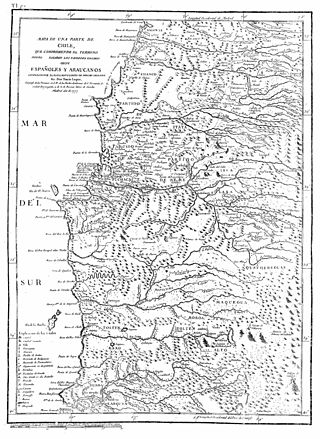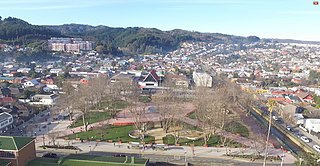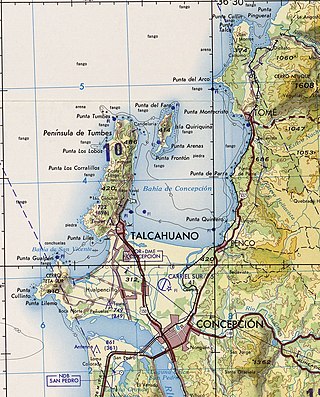
The Arauco War was a long-running conflict between colonial Spaniards and the Mapuche people, mostly fought in the Araucanía region of Chile. The conflict began at first as a reaction to the Spanish conquerors attempting to establish cities and force Mapuches into servitude. It subsequently evolved over time into phases comprising drawn-out sieges, slave-hunting expeditions, pillaging raids, punitive expeditions, and renewed Spanish attempts to secure lost territories. Abduction of women and war rape was common on both sides.

Penco, is a Chilean city and commune in Concepción Province, Bío Bío Region on the Bay of Concepción. Founded as the city of Concepción del Nuevo Extremo on February 12, 1550 by Pedro de Valdivia, it is the third oldest city in Chile, after capital Santiago founded first in 1541 and La Serena second in 1544.
La Frontera is a name used in Chile to refer to the region around the Bío Bío River, or to the whole area between it and the Toltén River. The use of this latter definition is largely coterminous with the historical usage of Araucanía. The term was coined during the period when the region was the frontier of the Captaincy General of Chile, then a part of the Spanish Empire and later the Republic of Chile, with the Mapuche people inhabiting the Araucanía following their revolt in 1598. Subsequently, the Spanish Empire established a system of forts between the Bío Bío River and the Itata River, as well as some within the Araucanía. This system continued through the 18th century and into the 19th century.
Club Hipico de Concepcion, also called the Mediocamino, is a Thoroughbred race track in Hualpen near Concepcion in the Bio-Bio Region of Chile. The track was opened in 1918. It features a right-handed nine-furlong dirt track. Currently, no major races are run at the Mediocamino.

The Andalién River is a river in the province of Concepción, in the Bío Bío Region of Chile. It drains the western side of Chile's Cordillera de la Costa and has a total length of 42 kilometres (26 mi). It is one of the two rivers that bracket the city of Concepción.

Battle of Marihueñu was one of the early decisive battles of the Arauco War; it took place between the Mapuche leader Lautaro and the Spanish general Francisco de Villagra on 23 February 1554.

The Bay of Concepción is a natural bay on the coast of the Province of Concepción in the Bío Bío Region of Chile. Within the bay are many of the most important ports of the region and the country, among them Penco, Talcahuano, and Lirquén.

Marihueñu or Marigueno is a large hill in the Nahuelbuta Range near the coast in the Lota commune of the Bío Bío Region of southern Chile. Its name is from the Mapudungun mari, "ten" and huenu, "heights". This height was within the Moluche aillarehue of Marigueno that lay between the Pacific Ocean and the lower reaches of the Biobío River north of the aillarehues of Arauco and Catirai. It was an important location during the Arauco War because it overlooked the coastal route to Araucanía from Concepción. The place is located on the coast to the south of Lota between Lota and Laraquete. It is bounded to the north by the valley of Colcura and to the south by the valley of Chivilingo.
Andalicán during the era of conquest and colonial times in Chile was the name of the high hill in the middle of two ravines and site of a fortress built by the Mapuche in 1557 to prevent García Hurtado de Mendoza from invading La Araucanía north of Marihueñu and the valley of Colcura. This height overlooks the location of the modern city of Lota in Concepción Province of the Bío Bío Region of Chile.

Valle de la Mocha is a plain in Chile on the north shore of the Bio-Bio River that contained the reducción of Mapuche who were transported in 1685, from Mocha Island by Governor José de Garro; from which the valley and plain took its name. Governor Domingo Ortiz de Rosas transferred the old city of Concepcion to this site from Penco after the May 25, 1751 Concepción earthquake.
The Battle of Lagunillas was a battle in the Arauco War on November 8, 1557, between the army of García Hurtado de Mendoza and the Mapuche army near some shallow lakes a league south of the Bio-Bio River.
During the siege of Concepcion of the Arauco War, 20,000 warriors of the army of the Mapuche laid siege to the Spanish garrison and civil population in the fortress of Concepcion, Chile.

Carampangue River is a small river in Arauco Province, Bío Bío Region of Chile. It has its main source in the hill of la Piedra, South of the Heights of Purgatorio in the Nahuelbuta Range southwest of the town of Santa Juana, and it runs to the Northwest to empty into the Bay of Arauco north of Arauco, Chile. In its upper half it receives several streams from the forests of the Nahuelbuta Range that flow shortly after into a lower section that traverses a fertile and open valley, in which the Pedro de Valdivia's fort of San Felipe de Rauco or Old Arauco was first built, and the town of this name that was on the north shore. Its main tributaries are the riachuelos of Conumo and of Los Patos. In the lowest reach of the river it has about 12 to 14 kilometers that allows the navigation of small boats.

Bay of Arauco or Bahia de Araucan, is a bay located on the coast of the Arauco Province, of the Bío Bío Region of Chile. The bay, is between the mountains of the Nahuelbuta Range to the east and to the west Santa Maria Island and northwest the Pacific Ocean. It is south and west of the Bay of Concepción and north of Arauco. The Bio Bio River flows into the bay at its northern end 10 kilometres (6.2 mi) west of the city of Concepcion. On its shores are the cities of Lota, Coronel and Arauco.
Negrete is a Chilean town and commune in Bío Bío Province, Bío Bío Region. It is bordered by the commune of Los Ángeles to the north, Renaico to the south, Mulchén to the east and Nacimiento to the west.
Talcamávida is a town in the commune of Hualqui in the Biobío Region of Chile. It is located on the north bank of the Bio Bio River across from Santa Juana on the opposite shore. It occupied a plain along the river 42 kilometres (26 mi) from the Pacific Ocean that is part of a small valley surrounded by to the north by a high wooded mountainous area. It is 40 kilometres (25 mi) from Yumbel, to the east northeast, 24 kilometres (15 mi) from Hualqui and 47 kilometres (29 mi) from Concepción to the north.

Fort Colcura was a small fort that was the first Spanish settlement that existed in the commune of Lota, Chile. It was on a small height on the edge of the Bay of Arauco, a little more than two kilometers to the southeast of the modern city of Lota. From its position it dominated the north slope of cerro Marihueñu and the valley of Colcura in whose extreme west is the mouth of the riachuelo Colcura that empties into the cove of Colcura.
Rere is a town located in the commune of Yumbel, Province of Biobío, in the Bío Bío Region of Chile. It takes its name from the Moluche language of the indigenous confederation, or aillarehue, that occupied both sides of the Claro River and made up the greater confederation, or Butalmapu, between the Itata and Bio Bio Rivers. In 1603, then Royal Governor of Chile under Spanish rule Alonso de Ribera was to declare the erection of the areas first fort naming it Nuestra Señora de la Buena Esperanza. Later, in 1765, the town of Villa de San Luis Gonzaga de Rere was founded on that site by governor Antonio de Guill y Gonzaga. Today Rere sits 21 km west of the town of Yumbel.
Presencia de América Latina, also known as Integración de América Latina, is a mural created by Jorge Gonzalez Camarena and painted by Mexican and Chilean artist Jorge González Camarena, Javier Arevalo ,Albino Echeverria, Eugenio Brito, Salvador Almaraz, Manuel Guillen and Hector Rodrigues.And Female model Alicia Cuevas, between November 1964 and April 1965. The 300-square-meter mural, painted in acrylics on rough stucco, is located in the lobby of the Casa del Arte of the University of Concepción, in Concepción, Chile. Its principal theme is the unity and brotherhood of the different Latin American cultures.

Lycée Français Charles de Gaulle is a French international school in Concepción, Chile. It serves primaire and secondaire levels.








